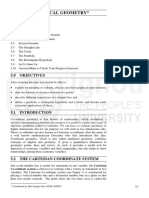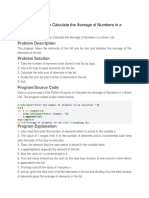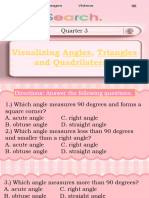ANALYTIC GEOMETRY
WITH CALCULUS
MATH 3C
Lenard Jacildo
OBJECTIVES
At the end of this module, you must be able to:
1. Plot points on a Cartesian Plane
2. Identify the coordinates of points plotted on the Cartesian Plane
3. Find the distance between points on a Cartesian Plane
4. Identify the coordinates of the midpoint of a segment.
5. Identify the slope of a line
6. Explore properties of Geometric Figures on a Cartesian Plane
The Cartesian Plane
The Cartesian Plane
Introduced in the 1630s. Aided the
development of calculus RENE DESCARTES (1596-
1650) and PIERRE DE FERMAT (1601-1665), French
mathematicians independently developed the
foundations for analytical geometry.
It was in “La Géométrie” that Descartes
first proposed that each point in two dimensions
can be described by two numbers on a plane, one
giving the point’s horizontal location and the other
the vertical location, which have come to be
known as Cartesian coordinates.
The Cartesian Plane
An ordered pair (𝑥, 𝑦) of real
numbers has 𝑥 as its first member and 𝑦
as its second member. The model for
representing ordered pairs is called the
rectangular coordinate system, or the
Cartesian plane.
The horizontal real line is usually
called the x-axis, and the vertical real line
is usually called the y-axis. Their point of
intersection is the origin. The two axes
divide the plane into four quadrants.
Points on the Cartesian Plane
Points are the basic unit of a
Cartesian Plane. All forms of geometric
figures are formed by infinitely many
points. On a Cartesian Plane, points are
named using a single CAPITAL LETTER.
Points on the Cartesian Plane
Each point in the plane is
identified by an ordered pair (𝑥, 𝑦) of real
numbers 𝑥 and 𝑦, called coordinates of
the point. The number 𝑥 represents the
directed distance from the 𝑦 − 𝑎𝑥𝑖𝑠 to the
point, and the number 𝑦 represents the
directed distance from the 𝑥 − 𝑎𝑥𝑖𝑠 to the
point. For the point 𝑥, 𝑦 the first
coordinate is the x-coordinate or
abscissa, and the second coordinate is
the y-coordinate or ordinate.
Points on the Cartesian Plane
In the figure, six points are plotted (A, B,
C, D, E and F).
1. Point B is at the origin; thus, it's coordinates
are (0, 0).
2. Point D is at Quadrant 1. Both x and y
coordinates are positive.
3. Point C is at Quadrant 2. The x-coordinate is
negative while the y-coordinate is positive.
4. Points A and F are in Quadrant 3. Both x and y
coordinates are negative.
5. Point E is at Quadrant 4. The x-coordinate is
positive while the y-coordinate is negative.
The Distance
Formula
The Distance Formula
The distance formula can be derived
using Pythagorean Theorem. Recall that in
Pythagorean Theorem, the square of the
hypotenuse is equal to the sum of the squares of
the two legs. In symbols,
𝒄𝟐 = 𝒂𝟐 + 𝒃𝟐
The Distance Formula
Now, using the Pythagorean theorem,
the distance between A and B is given as
𝒅= 𝒙𝟐 − 𝒙𝟏 𝟐 + 𝒚𝟐 − 𝒚𝟏 𝟐
Let’s have an example
1. Find the distance between the points (−𝟐, 𝟏) and 𝟑, 𝟒 .
Solution:
𝒅= 𝒙𝟐 − 𝒙𝟏 𝟐 + 𝒚𝟐 − 𝒚𝟏 𝟐
𝒅= 𝟑 − −𝟐 𝟐 + 𝟒−𝟏 𝟐
𝒅= 𝟑+𝟐 𝟐 + 𝟒−𝟏 𝟐
𝒅= 𝟓𝟐 + 𝟑𝟐
𝒅 = 𝟐𝟓 + 𝟗
𝒅 = 𝟑𝟒
𝒅 ≈ 𝟓. 𝟖𝟑
Try this
1. Find the distance between the points (𝟐, 𝟏) and 𝟒, 𝟓 .
𝟐 𝟏 𝟓
2. Find the distance between the points 𝟑
, − 𝟑
and 𝟔
,𝟏 .
3. Find the value of 𝒙 so that the distance between 𝒙, 𝟑 and 𝟐, −𝟏 is 5.
The Midpoint
Formula
The Midpoint Formula
The coordinates of the midpoint of the
line segment joining two points can be found by
averaging the x-coordinates of the two points and
averaging the y-coordinates of the two points.
That is, the midpoint of the line segment joining
the points (𝑥1 , 𝑦1 ) and 𝑥2 , 𝑦2 in the plane is
𝒙 𝟏 + 𝒙 𝟐 𝒚𝟏 + 𝒚𝟐
𝑴𝒊𝒅𝒑𝒐𝒊𝒏𝒕 = ,
𝟐 𝟐
Let’s have an example
1. Find the midpoint of the line segment joining the points (−𝟓, −𝟑) and 𝟗, 𝟑 .
Solution:
𝒙 𝟏 + 𝒙 𝟐 𝒚𝟏 + 𝒚𝟐
𝑴𝒊𝒅𝒑𝒐𝒊𝒏𝒕 = ,
𝟐 𝟐
−𝟓 + 𝟗 −𝟑 + 𝟑
𝑴𝒊𝒅𝒑𝒐𝒊𝒏𝒕 = ,
𝟐 𝟐
𝟒 𝟎
𝑴𝒊𝒅𝒑𝒐𝒊𝒏𝒕 = ,
𝟐 𝟐
𝑴𝒊𝒅𝒑𝒐𝒊𝒏𝒕 = 𝟐, 𝟎
Try this
1. Find the midpoint of the line segment joining the points (𝟐, 𝟏) and 𝟒, 𝟓 .
2. Find the value of 𝒙 so that the midpoint of the line segment joining 𝒙, 𝟑
and 𝟐, −𝟏 is 𝟑, 𝟏 .
The Slope of a Line
The Slope of a line
The slope of a nonvertical line is a measure
of the number of units a line rises (or fall) vertically
for each unit of horizontal change from left to right.
Consider the two points 𝑥1 , 𝑦1 and 𝑥2 , 𝑦2 on the
line.
As you move from left to right along this
line, a vertical change of
∆𝒚 = 𝒚𝟐 − 𝒚𝟏
units corresponds to a horizontal change of
∆𝒙 = 𝒙𝟐 − 𝒙𝟏
The Slope of a Line
The slope of a line refers to how
steep it is. The slope 𝑚 of a nonvertical line
passing through the points 𝑥1 , 𝑦1 and 𝑥2 , 𝑦2
is,
∆𝒚 𝒚𝟐 − 𝒚𝟏
𝒎= = , 𝒘𝒉𝒆𝒓𝒆 𝒙𝟏 ≠ 𝒙𝟐
∆𝒙 𝒙𝟐 − 𝒙𝟏
The Slope of a Line
Note that when using the formula for
the slope, it does not matter in which order you
subtract as long as you are consistent and
both “subtracted coordinates” come from the
same point.
𝒚𝟐 − 𝒚𝟏 −(𝒚𝟏 − 𝒚𝟐 ) 𝒚𝟏 − 𝒚𝟐
= =
𝒙𝟐 − 𝒙𝟏 −(𝒙𝟏 − 𝒙𝟐 ) 𝒙𝟏 − 𝒙𝟐
Let’s have an example
1. Find the slope of the line joining the points (𝟑, −𝟒) and 𝟓, 𝟐 .
Solution:
𝒚𝟐 − 𝒚𝟏
𝒎=
𝒙𝟐 − 𝒙𝟏
𝟐 − (−𝟒)
𝒎=
𝟓−𝟑
𝟐+𝟒
𝒎=
𝟓−𝟑
𝟔
𝒎=
𝟐
𝒎=𝟑
Try this
1. Find the slope of the line joining the points (𝟏, 𝟐) and −𝟐, 𝟒 .
𝟕 𝟑 𝟓 𝟏
2. Find the slope of the line joining the points ,
𝟖 𝟒
and 𝟒
, − 𝟒
.
𝟑
3. Find the value of x given that 𝒎 = − 𝟒 and 𝟓, 𝟑 and 𝒙, −𝟏 .
Note to remember
Note to remember






















































































